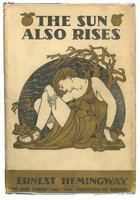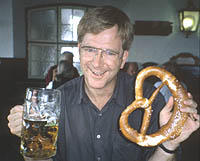Adapting the Written Word For Moving Pictures
 Following Walter Benjamin’s theory of the solitary writer and reader of the novel, I thought the following quotation was of some interest.
Following Walter Benjamin’s theory of the solitary writer and reader of the novel, I thought the following quotation was of some interest.“Writing, at its best, is a lonely life. Organizations for writers palliate the writer's loneliness but I doubt if they improve his writing. He grows in public stature as he sheds his loneliness and often his work deteriorates. For he does his work alone and if he is a good enough writer he must face eternity, or the lack of it, each day.”
-Ernest Hemingway, from his Nobel Prize acceptance speech
And now, with another quotation,.......................the blog!
“Generally film is found to work from perception toward signification, from external facts to interior motivations and consequences, from the givenness of a world to the meaning of a story cut out of that world. Literary fiction works oppositely. It begins with signs (graphemes and words) building to propositions which attempt to develop perception. As a product of human language it naturally treats human motivation and values, seeking to throw them out onto the external world, elaborating a world out of a story” (Andrew 456).
 Having been put on the spot this morning as to the relationship of the novel and film, I’ve revisited a film theory article this afternoon (or rather a published excerpt from a book in a film theory textbook) on film adaptation by Dudley Andrew. [I was also going to reread Seymor Chatman’s “What Novels Can Do That Films Can’t,” but I’m much too tired today to read this longer article as well as the one on adaptation.] In discussing the adaptation of prior texts to film, Andrew theorizes three modes in which this has been done: borrowing, intersection, and fidelity of transformation. In borrowing, the “artist employs, more or less extensively, the material, idea, or form of an earlier, generally successful text…Doutbless, in these cases, the adaptation hopes to win an audience ” (454). According to Andrew, the most common “borrowing” films are ones adapted from Bible stories, or Shakespeare. In this way, and much to the
Having been put on the spot this morning as to the relationship of the novel and film, I’ve revisited a film theory article this afternoon (or rather a published excerpt from a book in a film theory textbook) on film adaptation by Dudley Andrew. [I was also going to reread Seymor Chatman’s “What Novels Can Do That Films Can’t,” but I’m much too tired today to read this longer article as well as the one on adaptation.] In discussing the adaptation of prior texts to film, Andrew theorizes three modes in which this has been done: borrowing, intersection, and fidelity of transformation. In borrowing, the “artist employs, more or less extensively, the material, idea, or form of an earlier, generally successful text…Doutbless, in these cases, the adaptation hopes to win an audience ” (454). According to Andrew, the most common “borrowing” films are ones adapted from Bible stories, or Shakespeare. In this way, and much to the dissatisfaction of Francois Truffaut (I couldn’t find a copy of his essay “A Certain Tendency of French Cinema,” in which he discusses his distaste for the “cinema of quality,” which he said depended on the recreation of literary works, so I unfortunately can’t put in a quotation from him on this subject), the director depends on the prestige of a prior text for success with an audience. Another mode of adaptation is “intersecting,” in which “the uniqueness of the original text is preserved to such an extent that it is intentionally left unassimilated in adaptation” (454). In discussing this, Andrew refers to Diary of a Country Priest (Robert Bresson, 1951)—which I haven’t seen—and the use of Bresson’s featuring of the writing of the diary in the film. Andrew’s third mode of adaptation is the “fidelity of adaptation” in which “the task of adaptation is the reproduction in cinema of something essential about an original text” (455). This is the film in which the director wishes to remain faithful to the source—which sometimes leads to bad films. Andrew suggests the best manner in which to faithfully adapt a text is to reproduce the spirit of the source, and not to strictly
dissatisfaction of Francois Truffaut (I couldn’t find a copy of his essay “A Certain Tendency of French Cinema,” in which he discusses his distaste for the “cinema of quality,” which he said depended on the recreation of literary works, so I unfortunately can’t put in a quotation from him on this subject), the director depends on the prestige of a prior text for success with an audience. Another mode of adaptation is “intersecting,” in which “the uniqueness of the original text is preserved to such an extent that it is intentionally left unassimilated in adaptation” (454). In discussing this, Andrew refers to Diary of a Country Priest (Robert Bresson, 1951)—which I haven’t seen—and the use of Bresson’s featuring of the writing of the diary in the film. Andrew’s third mode of adaptation is the “fidelity of adaptation” in which “the task of adaptation is the reproduction in cinema of something essential about an original text” (455). This is the film in which the director wishes to remain faithful to the source—which sometimes leads to bad films. Andrew suggests the best manner in which to faithfully adapt a text is to reproduce the spirit of the source, and not to strictly  reproduce to the literary work. The best example that comes to mind right now is Trainspotting (Danny Boyle, 1996), which is adapted from a novel by Irvine Welsh. The novel is much longer, of course, and is set up as a series of narratives with no real protagonist. For the film, Boyle concentrated on one protagonist, Rent Boy (Ewan McGregor), and created a style that, although not based on Welsh, was in keeping with the spirit of the book. Although several incidences from the novel are in the film, Boyle departs from the source and creates new scenes that would better work in film. In fact, unlike the book, the film is slightly surreal, and includes several distinctly cinematic effects impossible to translate to novel form.
reproduce to the literary work. The best example that comes to mind right now is Trainspotting (Danny Boyle, 1996), which is adapted from a novel by Irvine Welsh. The novel is much longer, of course, and is set up as a series of narratives with no real protagonist. For the film, Boyle concentrated on one protagonist, Rent Boy (Ewan McGregor), and created a style that, although not based on Welsh, was in keeping with the spirit of the book. Although several incidences from the novel are in the film, Boyle departs from the source and creates new scenes that would better work in film. In fact, unlike the book, the film is slightly surreal, and includes several distinctly cinematic effects impossible to translate to novel form.
Andrew, Dudley. “From Concepts in Film Theory: Adaptation.” Film Theory and Criticism: Introductory Readings. Eds. Braudy and Cohen. New York: Oxford UP, 1999. 452-460.
 ASIDE: In class Professor Zemka referenced the French film Jules and Jim (Truffaut, 1961), which was adapted from a novel of the same name by Henri-Pierre Roché. Truffaut loved the book, but decided it was unfilmable until he saw The Naked Dawn (Edgar Ulmer, 1956). The following is an excerpt from his review of The Naked Dawn (Truffaut was a journalist prior to becoming a director), reprinted in the Criterion Dvd booklet:
ASIDE: In class Professor Zemka referenced the French film Jules and Jim (Truffaut, 1961), which was adapted from a novel of the same name by Henri-Pierre Roché. Truffaut loved the book, but decided it was unfilmable until he saw The Naked Dawn (Edgar Ulmer, 1956). The following is an excerpt from his review of The Naked Dawn (Truffaut was a journalist prior to becoming a director), reprinted in the Criterion Dvd booklet:“One of the most beautiful modern novels I know is Jules and Jim, by Henri-Pierre Roché, which shows how, over a lifetime, two friends and the woman companion they share love one another with tenderness and almost no harshness, thanks to an aesthetic morality constantly reconsidered. The Naked Dawn is the first film that made me think that Jules and Jim could be done as a film.”


1 Comments:
I was thinking about Truffaut's writings vs. his films when I wrote this blog, actually. From what I understand, he remained faithful to the novel Jules and Jim, but also added a lot of "cinema" to it. However, Truffaut adapted a number of novels for film in his career, and I think this was, at the very least, a small part of his falling out with Godard. I think Godard criticized Truffaut later in his career for the fact that Truffaut's film's, according to Godard, resembled the "cinema of quality" that Truffaut once railed against in print.
By M. Antonio, at 11:50 PM
M. Antonio, at 11:50 PM
Post a Comment
<< Home